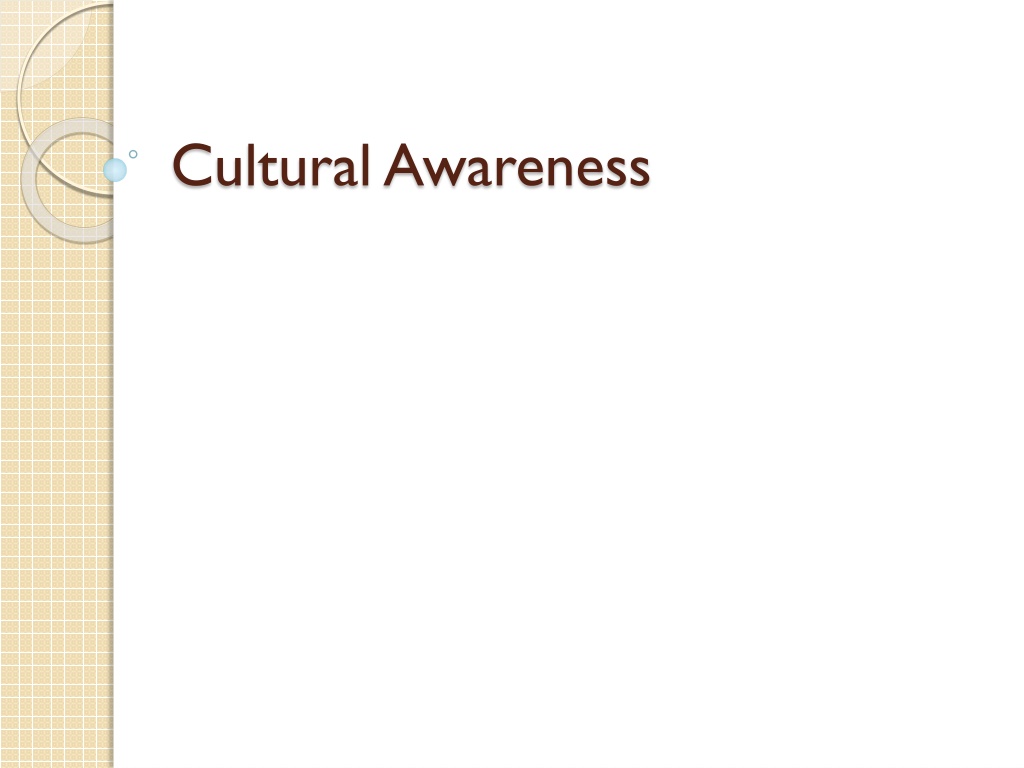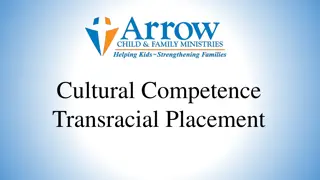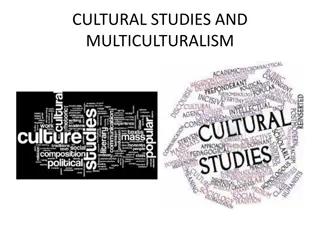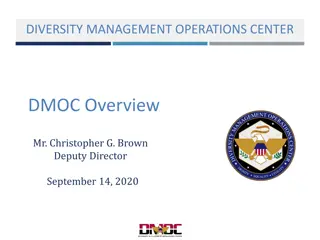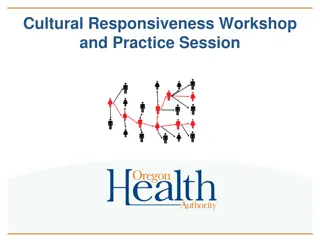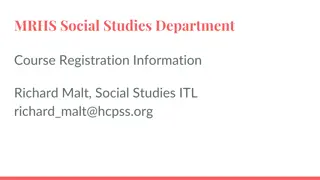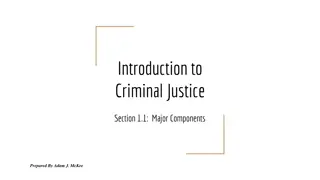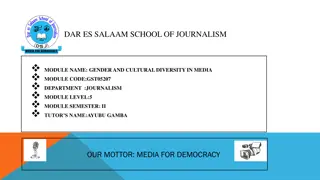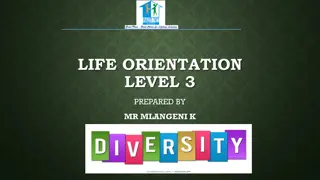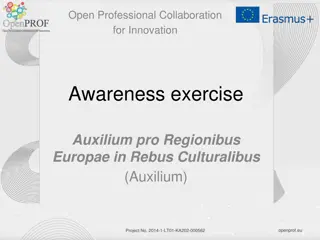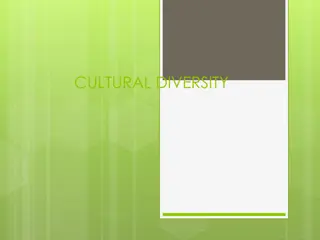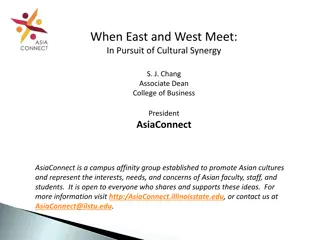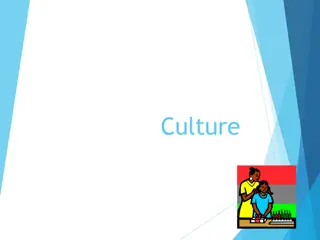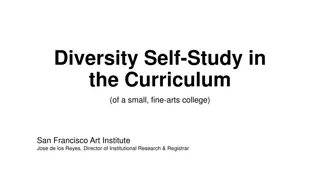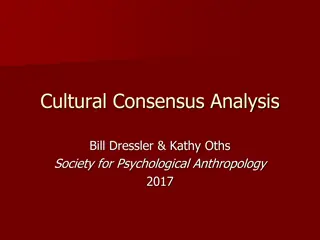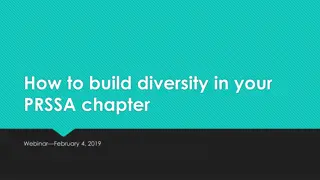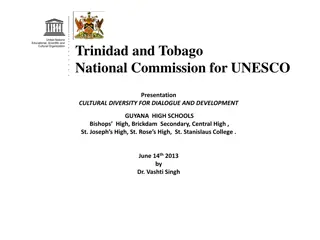Understanding Cultural Awareness and Diversity in the United States
Explore the significance of cultural awareness, including definitions of culture, cultural groups, and subcultures. Learn about the diversity in the United States based on national origins, beliefs, customs, and shared characteristics. Discover how to interact positively with individuals from different cultures and enhance your cross-cultural communication skills. Gain insights into the complexities of cultural heritage and the importance of embracing diversity.
Download Presentation

Please find below an Image/Link to download the presentation.
The content on the website is provided AS IS for your information and personal use only. It may not be sold, licensed, or shared on other websites without obtaining consent from the author. Download presentation by click this link. If you encounter any issues during the download, it is possible that the publisher has removed the file from their server.
E N D
Presentation Transcript
Goal To provide the knowledge, skills, abilities, to interact with individuals from cultures other than your own.
Performance Objectives Upon completion the student will be able to pass a written exam with a minimum score of 80% on the following topics: A.define the following: 1. culture 2. ethnic group 3. race 4. stereotype 5. bias 6. prejudices B.describe positive officer behaviors during contacts with members of a different culture
Definition Culture Culture is a broadly used term that refers to a complex group of shared characteristics including beliefs, values, and ways of thinking, behaviors, customs, or traditions. Culture is learned and can be passed from one generation to the next. It can condition an individual s thinking and influence both conscious and unconscious behaviors.
Definition Cultural Group A cultural group is an affiliation of individuals who collectively share any number of common sociocultural characteristics. Culture can be interpreted broadly, encompassing large groups of people from specific geographic or regional areas (e.g., Californians, New Yorkers, Midwesterners, etc.) or national origins (e.g., Mexicans, Germans, Japanese, Italians, etc.).
Definition Cultural Groupings Cultural groupings in the United States are most often associated with national origins. Cultural groups are based on factors (some physically distinguishable) that include, but are not limited to: Common history Common geographical basis Some political agreement Common beliefs Shared customs Similar artistic basis Morals, mores, and folkways Law by consensus Common linguistic bonds Common racial background
Definitions Subculture Group A subcultural group is comprised of people who have an association, most often voluntary, within a larger culture who have common values, beliefs, and experiences, and they develop close bonds or feelings of unity and pride with the identity of the subculture. Examples are: Law enforcement Criminal groups and gangs Gay, lesbian, bisexual, transgender Amish Sikhs
Discussion What is your own cultural heritage? How many generations were born in the United States?
Definition Ethnic Group An ethnic group is any group that can be distinguished on the basis of shared characteristics such as nationality, common ancestry, language, common history, race, etc. Individuals within an ethnic group may believe they are alike by virtue of a national origin, or other shared characteristics (ethnicity).
Cultural or Ethnic Groupings Provide a sense of security and establish a comfort zone where expected behaviors are known. Establish survival skills necessary to manage difficult situations and provide solutions for simple problems. Establish a pattern for living and forming relationships. Help individuals cope with, adapt to, or make sense of their physical environment. Offers a common ground which allows for effective communication.
Discussion Is there an issue with showing respect to a religion, where it doesn t jeopardize security? Native Americans Eagle Feathers? Muslim Prayer Rugs, Koran? Asatru Blessed Rocks?
Definition Race The term race or racial group usually refers to the categorization of humans into populations or ancestral groups on the basis of various sets of heritable characteristics. The physical features commonly seen as indicating race are salient visual traits such as skin color, cranial or facial features, and hair texture. While racial categories may be marked by sets of common traits, the popular idea of race is a social construct without base in scientific fact.
Definition Racism Racism is a doctrine that one race is inherently superior (physically, intellectually, or culturally) to another.
Definition Stereotypes A stereotype is a preconceived or over- simplified generalization involving negative or positive beliefs about another group. When an individual is stereotyped, that person is perceived as having specific behavioral traits and abilities.
Basis of Stereotyping Stereotypes can be based on a number of factors including, but not limited to: nationality ethnicity race gender sexual orientation socioeconomic status age physical ability Stereotyping is a natural human tendency.
Dangerous Assumption Additional Information Characteristics of the group are accurate Probably incorrect, the reliability of the information should be considered No single individual has all the characteristics of the group; no group s characteristics can describe a single individual. All member so the group share the same characteristics Stereotype
Stereotype Past experiences of individual members of a cultural group or ethnic group can shape their attitudes and expectations regarding the role of government and law enforcement. The following slides identifies several common stereotypes individuals may have of law enforcement officers.
Stereotype of Officers Officers are apathetic . Reinforced by . Insensitive actions and lack of empathy Countered by . Considering their own safety and the safety of others at all times, demonstrating empathy, and being sensitive to the person s needs and concerns
Stereotype of Officers Officers are unethical and engage in unprofessional behavior . Reinforced by . Accepting gratuities, abusing authority, adhering to a code of silence, officer brutality, corruption or abusing publicly owned equipment Countered by . Adhering to the Law Enforcement Code of Ethics/Code of Professional Conduct, holding themselves and peers to the highest standards of behavior, and using public vehicles for public business only
Stereotype of Officers Officers discriminate . Reinforced by . Targeting certain groups, or applying different standards of enforcement or assistance to different groups in the community Countered by . Being aware of their own stereotypes, treating all people in a professional manner, remaining impartial and not allowing a bad experience on one call to affect judgement on another
Stereotype of Officers Officers project a poor public image . Reinforced by . Presenting a poor physical image (e.g., overweight), sloppy uniforms, or inappropriate demeanor or body language (e.g., acting tough to intimidate others) Countered by . Adopting a lifestyle conducive to lifelong fitness, demonstrating pride in their personal appearance, controlling their temper and emotions, and treating others as they would wish to be treated
Stereotype of Officers Officers are unable or unwilling to handle situations . Reinforced by . Inadequately trained officers dealing with situations for which they are not prepared, or officer inability or unwillingness to apply trained job skills. Countered by . Responding promptly and courteously to all calls, and acknowledging their own limitations and calling for assistance when needed.
Definition Bias Inclination or prejudice for or against one person or group, especially in a way considered to be unfair. Bias comes in many forms, including race, age, gender, and ethnicity and can be universal or location specific. Biased individuals believe the biases they are applying to others are right without regard for the truth.
Definintion Prejudices Prejudice is a prejudgment or point of view about a person or group of individuals that is usually formed before the facts are known.
Prejudice Prejudice is a: process, not a static attitude learned attitude way of thinking about others that may be based on: Misconceptions Misunderstandings Inflexible generalizations
Prejudice Occupational cultures, including law enforcement, may be susceptible to developing and passing on prejudices against those who are outsiders, or not within their group (i.e., individuals within the community). Certain us versus them attitudes may develop.
Prejudice Because law enforcement officers have certain powers over members of a community, prejudicial attitudes could lead to potential abuse and must never be tolerated within a law enforcement agency. Overlooking or allowing expressions of prejudice can lead to: lack of trust within the organization adverse attention from the media lack of trust within the community complaints or lawsuits disciplinary action or dismissal
Discussion You and your partner are having a discussion when an African American male approaches and interrupts. He is obviously very excited, out of breath, and is having difficulty describing what he has just seen. Your partner, who is Anglo American, responds to the man in slang dialect and says, Hey man, settle down Homey. Jus take a breath an tell us what you want, Bro . What would you do? Would you say anything to the man? If so, what? Would you say anything to your partner? If so, when and what?
Positive Behaviors and Different Cultures Peace officers must recognize that one of the most reliable strategies for successful contacts with individuals from differing cultural, racial, or ethnic backgrounds is to treat all individuals and groups with dignity and respect.
Positive Behaviors and Different Cultures A primary goal of peace officers is to obtain complete and accurate information in a safe manner. Officer conduct and actions when first making contact with an individual with a different cultural background can serve to either enhance or hinder this process.
Positive Behaviors and Different Cultures Developing appropriate contact and communication skills can: improve the quality of the information gathered from the individual enhance cooperation of the individual and other members of the community increase officer confidence and professionalism demonstrate a caring attitude enhance officer safety reinforce a positive image of law enforcement within the community
Positive Behaviors and Different Cultures Individuals who do not speak English may not understand why they are being stopped or approached by a peace officer. They may be unfamiliar with the legal system and unaware of their rights.
Positive Behaviors and Different Cultures When attempting to communicate with an individual who speaks little English or for whom English is a second language, officers should: be patient speak slowly and clearly speak at a normal volume (Speaking louder will not help comprehension.) face the person they are addressing (even when using a translator) use short, simple sentences pause frequently allow enough time for the person to formulate responses repeat statements or questions in different ways, if necessary use gestures, actions, or written text to aid understanding provide feedback and encouragement summarize what the individual is saying to check comprehension
Use of By officers can Negatively effect the professional image of the officer Profanity Detract from professional effectiveness; make individuals reluctant to cooperate; demonstrate a lack of cultural, racial, or ethnic awareness; indicate a lack of sensitivity for the feelings of others. Derogatory or offensive language Law enforcement jargon Cause confusion and mistrust; be demeaning to the individual Communication
Discussion You are conducting a required random cell search. The inmate of the assigned to that cell is angry and states, You are only searching me just because I m ________! Describe how you would handle the situation. What would you say to the person?
Discussion Your coworker on asks to speak with you about an upcoming department party. He tells you, I am gay and I don t feel comfortable attending. Do you think I should bring my partner? How would you respond to this question? What are the issues presented? What work conditions keep people from being comfortable with their sexual orientation? How do organizations include, exclude employees?
